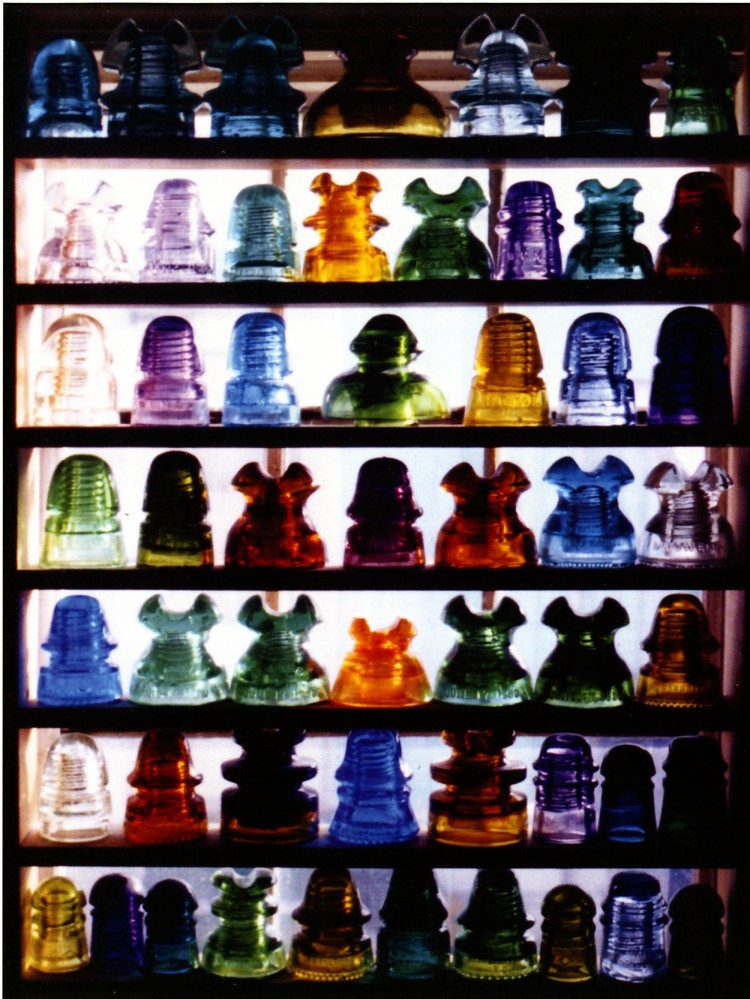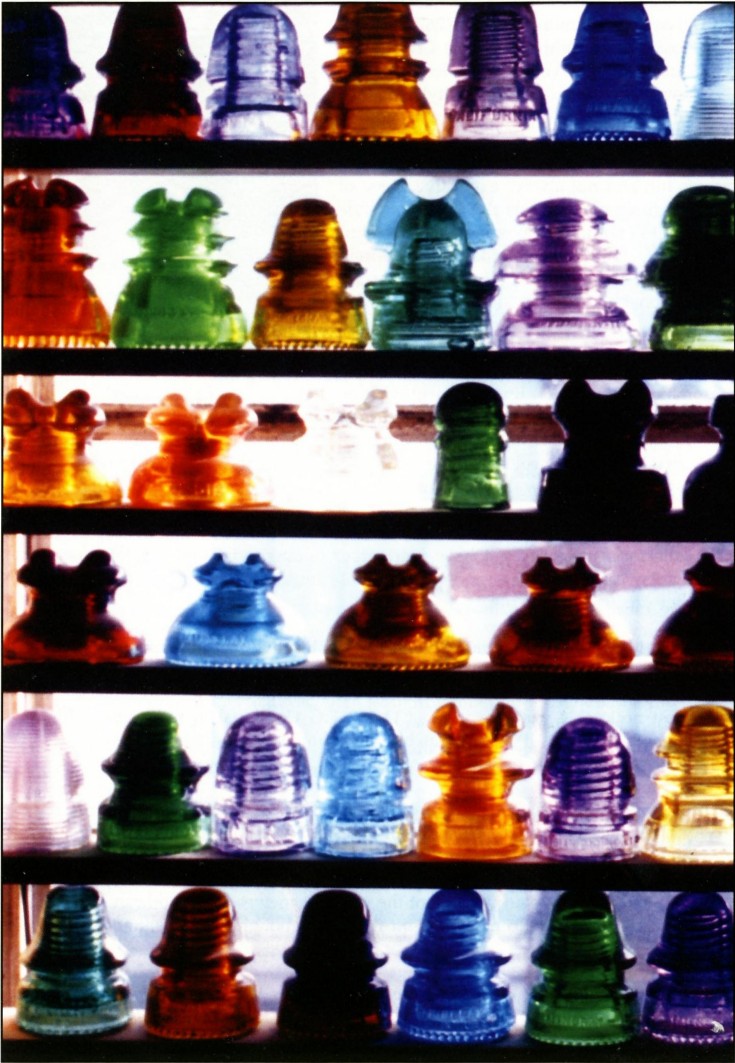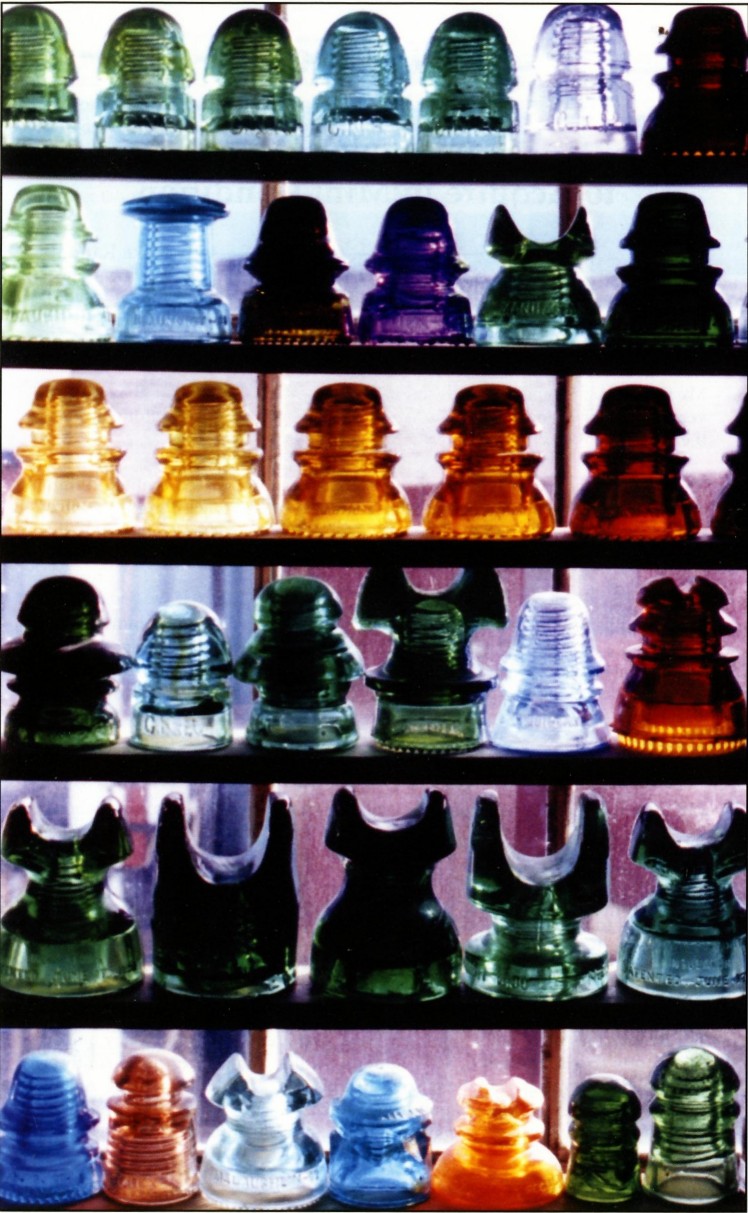All About Color
By Mike Randall
Reprinted from "Crown Jewels of the Wire", May 2006, page 29
27 Years of Collecting Glass
I started collecting glass in 1979. I had just moved from Los Angeles to
Redding, CA. Los Angeles was such a wonderful place to live that I missed being
there for... oh, at least ten minutes after I left.
Getting settled on a small cattle ranch, I heard about a flea market on
Saturdays only a few miles from my home. So as soon as my wife would cut me
loose from the task of unpacking boxes, I went decided to check it out. On a
table was a small, aqua bottle with some letters embossed on the glass. The
price was $1. I paid it, took the bottle home, and placed it in a window. That
was it. I was hooked.

Sunlight adds sparkle to Mike Randall's Crown Jewels of the Wire.
Within a year I had about a hundred old bottles displayed in a china cabinet
my wife reluctantly gave up. Most of the bottles were chipped, stained, cracked,
or all of the above. But I thought someone from the Smithsonian Institute was
going to be knocking on my door at any time asking me to donate the bottles to
their museum. In time I joined the Redding Bottle Club and started attending
shows. I developed a liking for figural bottles, and became attracted to colored
glass.
In 1984, I became a medic for the city of Concord, CA. Minus a wife and
cattle ranch, I spent my earnings on colored bitters bottles. I had an aqua
Pocahontas barrel (one of only 15 known), a yellow Indian Queen, Ear of Corn,
etc. While the collection contained only a couple dozen pieces, it was worth
many thousands.
But bottles are sensitive creatures. Just a slight temperature change in a
room can cause a rare bottle to grenade. A pot stone in the glass can suddenly
turn into a massive crack. I sold my collection after coming home one time and
finding a new six-inch crack in a high dollar bottle.
A few years later I found myself back in Redding working in an antique store.
Having always admired the colors and shapes of insulators, I now began
collecting them. In about four years I had put together a nice collection of
one-hundred pieces, from common to rare. Then I moved to Oregon. Away from my
friends I found my collection wasn't as important to me as I thought. But the
need for money was, and so I made a big mistake and sold my collection. I
realized six months later how much I also missed my insulators.
Moving from the Oregon Coast to Medford, I became a vendor in one of the
region's largest antique malls. Success there gave me extra spending money, and
I started collecting insulators once again.
But this time I set some parameters on what I would collect. No aqua or clear
glass. No CD numbers above 267.5. When possible, I sought to obtain a CD style
in three different colors. While that's not always possible in some CD styles,
in others I have dozens of different colors.
If you are new to the hobby, type collecting is fun and not always expensive.
One of my three piece sets is the Canadian style CD 145 with no embossing. They
remind me of CD 143's on steroids. I have them in yellow, light green and peach.
They are reasonably priced and look great in a window.
Today I have about 150 insulators in my main collection. Every morning I let
mother nature do her thing. Having my collection in my east-facing living room
windows, I watch the sun come up. Shelf by shelf, my collection comes to life.
Watching the spectacle, I find myself saying aloud, "Now that is
beautiful!"

Mike Randall
Mankind (back lighted show cases) versus mother nature's sunlight is up to
each collector's preference. I have seen super dooper, wizbang, hightek, spendy
display cases that are supposed to emulate sunshine. Pardon my opinion, but they
are just so-so to me.
True, I have a sapphire blue NEGM CD 145 beehive that in a case looks better
than in sunlight. But I also have a yellow amber signal that becomes an ordinary
honey amber in that same case. A milky cobalt signal becomes bluish black. The
most noticeable example is my CD 162 HG Co signal in red amber. It's a
"glower"; and it's 100% brilliant, bright red amber. In sunlight! In a
show case, it looks mud brown by comparison. But, hey, that's my opinion.
In the antique business your income falls off in the winter months. So a few
winters ago I decided to pace myself and put my insulator spending on a tight
budget. But I had been looking for a CD 151 NATCO in peacock blue from some
time. One came up for sale so I had it shipped to me for inspection. I opened
the box, and put the beauty on one of the window shelves. Well, you can guess
the result. I couldn't help myself. I bit the bullet, bought the blue, and blew
my budget.
Editor's note: Three of the window displays from Mike's collection are shown
on pages 29, 32 & 33. Also, starting on page 34, Mike reports on his search for select
Hemingray CD 241's. Colored pictures are shown on pages 35 & 36.
(page 31)

(page 32)

(page 33)
| 